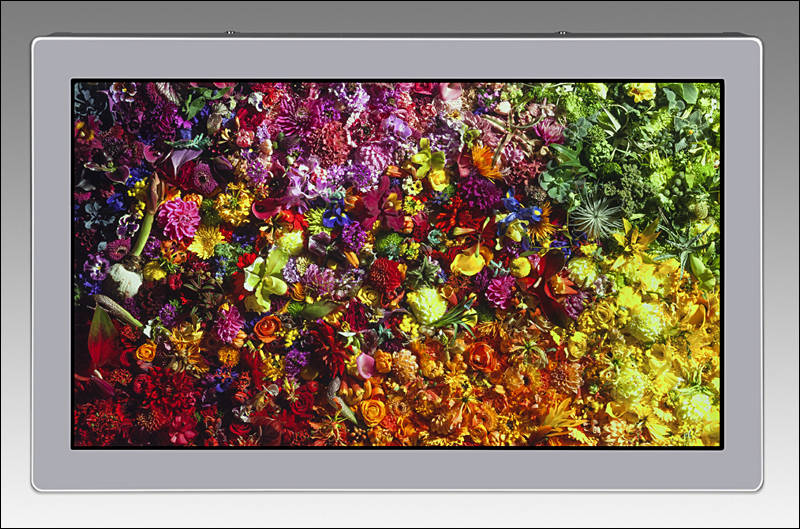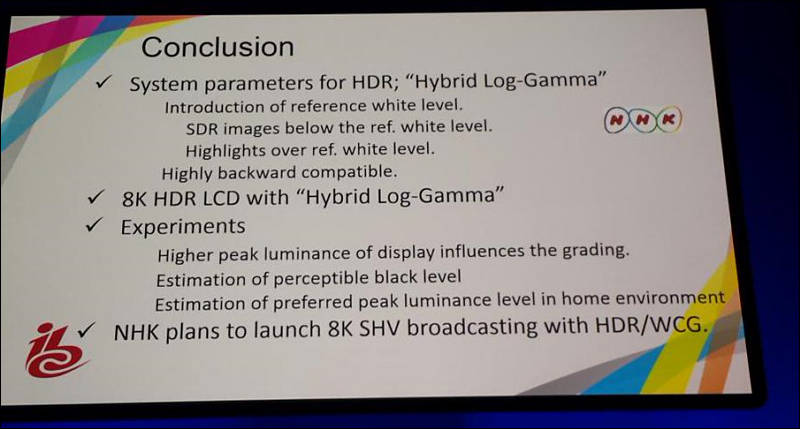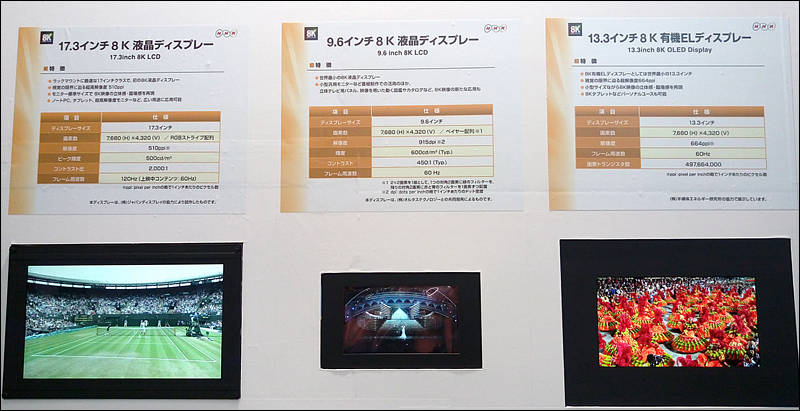
It allows to keep PV going, with more focus towards AI, but keeping be one of the few truly independent places.
-
This will be great for theatre, and I don't see it being at mass consumer prices for many many years. They have to milk 4k first!
You can be wrong here. As 8K panels allows very good glass free 3D also :-)
Companies have no trouble producing panels with necessary density already.
-
Japan Broadcasting Corporation (NHK) has developed a large 133Mpixel CMOS image sensor capable of processing the millions of pixels required for each of the red (R), blue (B), green (G) colors of 8K video, in a single and compact element.
A single Super Hi-Vision (8K SHV) video frame consists of approximately 33 million pixels. The first 8K video cameras used three 33 MPixel image sensors in order to process the Red (R), Blue (B) and Green (G) color information, making the cameras more bulky.
NHK's new 133 Mpixel CMOS (15,360 x 8,640 pixels) is capable of processing the RGB information itself, allowing for the development of smaller, single-chip 8K cameras.
The new CMOS is capable of shooting 8K video a 60 FPS. Its light receiving surface is 43.2mm (diagonal), equivalent to 35mm full-frame.
-
8K test in Fifa World Cup 2014 (tv news report):
The 133MP sensor:
http://www.nhk.or.jp/strl/open2014/tenji/tenji20/index_e.html
-
There is a long living for 1080p, and maybe it will not be surpassed by 4k, maybe both will coexist for tv broadcast and cinema theaters for long time...
In my country 4K is expected to become a default broadcast signal only in 2022 and I believe not all TV stations will upgrade so fast, because most of people will not buy another tv set (4k) if they already have a ful lhd (1080p) tv set. I feel there will be a long coexistence for 1080p and 4K in cinema and tv.
If someday 8K turns into a popular broadcast signal with affordable tv sets to buy, things will become weird... The resolution is so high...
The first time I saw a 4K TV set was in the shopping mall in a big store. It was a Sony 55 inch 4K tv with a sony demo 4k footage showing a soccer game. This was some months ago. I saw this same tv set some days ago in a FIFA world cup event showing the same 4k soccer footage. Both times I had the same sensation. I had a feeling that the reality was in front of me, it was almost the same thing of seeing the game in the stadium, almost a virtual reality... It was weird... The image was no more a representation of the reality, it was almost the reality...
So, I think the 8K broadcast shoot with a 133 megapixels sensor will be so good in resolution and dynamic range will be so improved in future sensor technology that it will make us to be confused if we are seeing a tv set or if we are seeing the reality in "personal-view"... Don't be scared if you respond good night to a talking head in a 8K tv... Wild life, nature, travel and so on will be so amazing quality in 8k that people will not need to travel, to journey anymore... this will hurts transport and host business. Porn movies will make you accomplish your fantasy to be togheter with the pornstar... Just buy an automatic sex handjob machine and plug it into the automatic rhythmic usb port of the 8k "violet-ray" player... I can imagine enourmous screens in the malls, restaurants, pubs, showing different kind of images which will confuse you with the reality, scenarios, virtual places will be built in pubs, restaurants, nightclubs...
The pixel is so small to be perceived even close to the screen. an image with the same size of a urban bus can be seen only 3 meters away without perceiving the pixels. I did a draw in a white wall of black square pixels with 1 milimeter in size forming a diagonal line, some kind of a stairs of pixels. I started to walk backward and when I was at 3,33 meters away it turned into a line, no more stairs. So a 8K image shoot with the 133 megapixel sensor can have 7,68 meters horizontal by 4,32 meters vertical and I will not see the pixels at 3,33 meters away... smaller screens can be seen even closer... this will be the reality in front of me... it will surpass the concept of a tv or cinema, it will turn into something else... For more than one century the image and sound makes people to cry... This 8K thing in 3D will make people to pee...
-
8K TVs from LG Electronics and Sony will be on display and consumers can also expect to see a new lineup of QD TVs.
CES 2015 :-)
-
It has become clear that Japan is planning to launch an 8K SHV test broadcast and then promptly restructure the UHD service. Apple has also announced that they will release the ‘iMac 8K’ with a super-high resolution display later this year. Korea is also preparing to offer an 8K service demonstration at the 2018 Pyeongchang Winter Olympics. LG Display displayed a new beacon of the 8K era by revealing their 98-inch 8K Color Prime Ultra HDTV at CES 2015.
-
Panel makers aim to tackle the 8K market starting 2018 when Japan will offer various channel transmissions in 8K, and the World Cup is held in Russia. Demand will continue to grow around 2020 when major sporting events will be held in Japan.
Makers such as BOE and Sharp have so far shown some of the most active development in 8K panels, despite that 4K TVs are expected to hold over just a 13% share of global LCD TV sales in 2015.
Sharp will play a major role in supplying 8K panels in the future and will use 10G facilities to produce the technology, while BOE aims to do so at its 10.5G fabs, with an emphasis on 98- and 82-inch units. LG Display meanwhile is currently looking to production of 55- and 98-inch
-
According to IHS, shipments of 8K (7680 by 4320 pixels) TVs are expected to increase from 2,700 shipped worldwide in 2015 to 911,000 in 2019.
Huh.
-
The 133 megapixels sensor to allow four pixels:
R G
G B
to capture one pixel in the 8K video:
-
Innolux will begin mass producing 8K TV panels by the second quarter of 2016, according to company remarks at Touch Taiwan 2015.
The company displayed new 8K 65-inch TV panels at the Touch Taiwan exhibition running from August 26-28 in Taipei. The company said such technology in addition to 75-, 85- and 100-inch TV displays will go into mass production in second-quarter 2016.
-
If you want to get a glimpse of what Youtube thinks "8k" quality is: This video is available from there in 7680x4320:
The 4320p version is streamed by Youtube in embarrasing 23 MBit/s, and looks like shit whenever there is motion/complexity in the scenery.
I guess the good news is that now you can upscale your 1080p videos to 4320p, and ask your Youtube viewers to downscale them back to 1080p, giving them an adequate bandwidth (23 MBit/s) for 1080p viewing without noticable compression artefacts. Let's hope Youtube will stream 16k videos soon, with a bandwidth reasonable for 4k content... :-)
-
Gosh - I'm still trying to max out on 1080p and everybody's soon to aim at 8k
-
Sharp is expected to release 8K monitors aimed at the B2B segment in Japan by the end of October 2015 as part of its first step in commercializing the technology, according to Japan media.
Japan is moving toward 8K resolution as a national standard by 2020 and makers estimate that 8K could reach a penetration of 30% by 2018 in the TV segment. Pushing 8K monitors into the market would be a first step for gaining visibility in the 8K segment, and Sharp has already begun to see orders from major outlets such as NHK Television Network, the reports said.
The company's 8K monitors sized 85-inch will come equipped with IGZO display technology and be priced initially at around US$12,500-13,300. Sharp will first promote the technology in the medical segment, art museums and broadcasting units.
-

Japan Display Inc. ("JDI") has announced the development of the world's first 17.3-inch high resolution (7,680(W) x RGB x 4,320(H) pixels), fast response (frame rate 120Hz) liquid crystal display (LCD) module, the same size as the standard monitor commonly used for the video image production.
The LCD module, based on low temperature poly-silicon (LTPS) technology with true 8K pixels (RGB stripe arrangement), realizes high definition (510ppi) images, and the 120Hz frame rate enables smooth playback of moving image. By providing wide viewing angle, high contrast and little color shift, the advantages of IPS technology enable reproduction of life-like 8K image with a sense of depth in image quality.

 zebra81.jpg800 x 529 - 129K
zebra81.jpg800 x 529 - 129K -
Hisense will begin selling 8K TVs by the end of 2015, according to company management as quoted in a report from Japan-based Nikkei Electronics.
The report said Hisense believes that China's consumers are increasingly aware of growing TV trends in China and have already familiarized themselves with Ultra HD (4K) content. The consumers are also aware that the next stop in terms of resolution is 8K and they want the best of the best regardless of the limited content in the market, according to the report.
-
It seems that lens resolution will be an issue for the 8k video. In the lenstip website they do measurements about lens resolution in line pairs per milimeter (lp/mm) and also with resolution charts.
The average resolution for a full frame lens is around 45-50lp/mm and a great m43 lens is around 77-82lp/mm. The resolution charts shows the lenses at around 2000 - 2600 lines resolution maximum in still photos. Using a full frame lens in m43 sensor is worse because the sensor magnify the center area so the lp/mm will be half compared to same lens in a FF camera, a focal reducer can help a lot.
So the still lenses can work good up to 4k resolution, sometimes lower resolution than 4k video, and maybe for 8k video there will be the need of new special lenses, high price.
Considering that the indie people can buy only low price lenses, so work with 8k video will not make sense. 4k video is the maximum resolution for our photo/still lenses, no matter they are m43, aps-c or ff lenses.
Example: the 12-35 lens at f4 is around 77lp/mm in the image center, the GH4 sensor in 4k is 8.1mm height, doing the maths this lens will resolve around 1250 lines in GH4 4k video.
The new full frame Sigma Art 20mm 1.4 can do around 47lp/mm, so it will resolve around 770 lines in GH4 4k video. With a focal reducer this can increase to around 1080 lines. Most good Full Frame lenses are around a 50lp/mm maximum, and this is stoped down to f5.6
In a full frame camera, considering the sensor 36 x 20,25mm, this same sigma lens can resolve around 1900 lines.
The RGB bayer pattern decreases the camera resolution a little bit, around 1,33x less than the pixel count, so a 2160p video will deliver a maximum 1620 lines. The GH2 is 1080p and is around 810 lines.
Lens resolution is a good reason for Panasonic release new cameras with the multi aspect sensor, a bigger sensor can use more image area form the lens and record higher resolution, more lp/mm. The GH4 sensor is 8.1mm height, 1250 lines with the 12-35 lens. The multiaspect sensor with 3840x2160 pixels for video would be 10,09mm height, and could record 1560 lines from the same lens.
All these maths shows that 4k video is the sweet spot resolution for a video camera and for the lenses we can buy, and all these maths are in image center, in corners the lenses resolution is worst.
-
Panel makers in China and Japan have already begun staking their claim in the market and Samsung Display along with LG Display are anticipating that 8K will begin taking off as early as 2018 and into 2020.
Huh.
-
Panasonic will once again develop image sensors after freezing such operations for the last few years, aiming for applications including 8K ultrahigh-definition technology.
Image sensors turn light into electronic signals, and are used in digital cameras, smartphones and other devices. CMOS (complementary metal-oxide semiconductor) sensors are a well-known type. Panasonic will spend around 10 billion yen ($80.8 million) to develop next-generation image sensors, with plans to release them in fiscal 2018.
http://asia.nikkei.com/Business/Companies/Panasonic-resuming-image-sensor-R-D-with-eye-on-8K
-
8k makes sense for IMAX theaters. I saw Star Wars VII in IMAX 4k bbbiiiiiggggg screen and I can see the pixels even from last seat.
Interesting thing: how good 35mm film is... IMDB reports Star Wars VII have scenes done with 35mm film and it looks good in the bbbiiiggg screen, a little soft, but beautiful.
Howdy, Stranger!
It looks like you're new here. If you want to get involved, click one of these buttons!
Categories
- Topics List23,979
- Blog5,725
- General and News1,352
- Hacks and Patches1,153
- ↳ Top Settings33
- ↳ Beginners255
- ↳ Archives402
- ↳ Hacks News and Development56
- Cameras2,362
- ↳ Panasonic991
- ↳ Canon118
- ↳ Sony156
- ↳ Nikon96
- ↳ Pentax and Samsung70
- ↳ Olympus and Fujifilm100
- ↳ Compacts and Camcorders300
- ↳ Smartphones for video97
- ↳ Pro Video Cameras191
- ↳ BlackMagic and other raw cameras116
- Skill1,961
- ↳ Business and distribution66
- ↳ Preparation, scripts and legal38
- ↳ Art149
- ↳ Import, Convert, Exporting291
- ↳ Editors191
- ↳ Effects and stunts115
- ↳ Color grading197
- ↳ Sound and Music280
- ↳ Lighting96
- ↳ Software and storage tips267
- Gear5,414
- ↳ Filters, Adapters, Matte boxes344
- ↳ Lenses1,579
- ↳ Follow focus and gears93
- ↳ Sound498
- ↳ Lighting gear314
- ↳ Camera movement230
- ↳ Gimbals and copters302
- ↳ Rigs and related stuff272
- ↳ Power solutions83
- ↳ Monitors and viewfinders339
- ↳ Tripods and fluid heads139
- ↳ Storage286
- ↳ Computers and studio gear560
- ↳ VR and 3D248
- Showcase1,859
- Marketplace2,834
- Offtopic1,319











